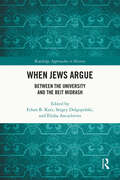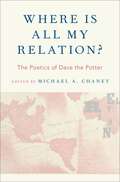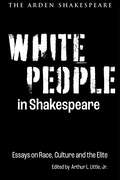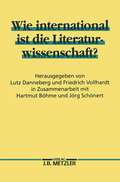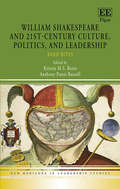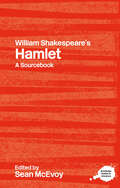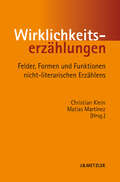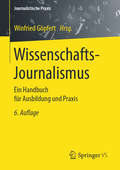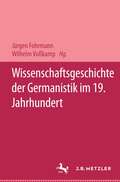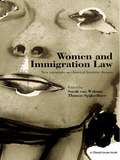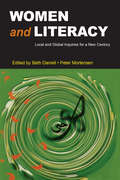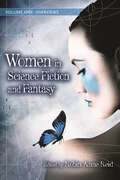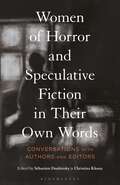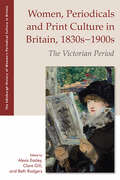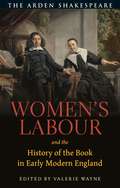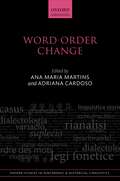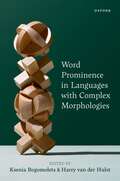- Table View
- List View
What Forms Can Do: The Work of Form in 20th- and 21st- Century French Literature and Thought (Contemporary French and Francophone Cultures #69)
This volume responds to important questions about the formal properties of literary texts and the agency of form. A central feature of twentieth- and twenty-first century French and Francophone writing has been the exploration of how cultural forms (literary, philosophical and visual) create distinctive semiotic environments and at the same time engage powerfully with external realities. How does form propose a bridge between the environment of the text and the world beyond? What kinds of formal innovations have authors devised in response to the complexity of that world? How do the formal properties of texts inflect our reading of them, and perhaps also our apprehension of the real? In addressing such questions as they apply to a wide corpus of texts, including the novel, life writing, the essay, travel writing, poetry and textual/visual experiments, the chapters in this volume offer new perspectives on a wide range of creative figures including Proust, Picasso, Breton, Bataille, Ponge, Guillevic, Certeau, Camus, Barthes, Perec, Roubaud, Chauvet, Savitzkaya, Eribon, Ernaux, Laurens and Akerman. Collectively, they renew the engagement with form that has been a key feature of French cultural production and of analysis in French studies.
What is Good Academic Writing?: Insights into Discipline-Specific Student Writing (New Perspectives for English for Academic Purposes)
The field of English for Academic Purposes (EAP) developed to address the needs of students whose mother tongue is not English. However, the linguistic competence required to achieve academic success at any university where English is the medium of instruction is a challenge for all students. While there are linguistic features common to academic literacy as a general genre, closer investigation reveals significant differences from one academic field to another. This volume asks what good writing is within specific disciplines, focussing on student work. Each chapter provides key insights by EAP professionals, based on their research in which they bring together analysis of student writing and interviews with subject specialists and markers who determine what 'good writing' is in their discipline. The volume includes chapters on established disciplines which have had less attention in the EAP and academic writing literature to date, including music, formal linguistics, and dentistry, as well as new and growing fields of study such as new media.
What’s Wrong with Antitheory?
Antitheory has long been a venerable brand of theory and – although seemingly opposite – the two impulses have long been intertwined. Antitheory is the first book to explore this vexed relationship from the 20th century to the present day, examining antitheory both in its historical context and its current state. The book brings together leading scholars from a wide range of Humanities disciplines to ask such questions as: · What is antitheory? · What does it mean to be against theory in the new millennium? · What is the current state of post-theory, the alleged deaths of theory, and the critique of critique?
When Jews Argue: Between the University and the Beit Midrash (Routledge Approaches to History)
This book re-thinks the relationship between the world of the traditional Jewish study hall (the Beit Midrash) and the academy: Can these two institutions overcome their vast differences? Should they attempt to do so? If not, what could two methods of study seen as diametrically opposed possibly learn from one another? How might they help each other reconceive their interrelationship, themselves, and the broader study of Jews and Judaism? This book begins with three distinct approaches to these challenges. The chapters then follow the approaches through an interdisciplinary series of pioneering case studies that reassess a range of topics including religion and pluralism in Jewish education; pain, sexual consent, and ethics in the Talmud; the place of reason and devotion among Jewish thinkers as diverse as Moses Mendelssohn, Jacob Taubes, Sarah Schenirer, Ibn Chiquitilla, Yair Ḥayim Bacharach, and the Rav Shagar; and Jewish law as a response to the post-Holocaust landscape. The authors are scholars of rabbinics, history, linguistics, philosophy, law, and education, many of whom also have traditional religious training or ordination. The result is a book designed for learned scholars, non-specialists, and students of varying backgrounds, and one that is sure to spark debate in the university, the Beit Midrash, and far beyond.
Where Is All My Relation?: The Poetics of Dave the Potter
Where Is All My Relation? presents the first sustained academic discussion of the poetry, pottery, and culture of David Drake, an antebellum slave who distinguished himself by composing verse on the ceramics he produced in the years leading up to the Civil War. During the 1830s, 40s, and 50s, he incised couplets and signatures (a singular "Dave") onto the incredibly large storage vessels that he made. In fact, his stoneware pots and jars are among the largest made in North America during the antebellum era, and craft enthusiasts and appraisers are still proclaiming their precision and ambitious volume. Rich with biblical allusions, historical facts, and personal opinions, his art provides unique insights into the lives of slaves, craftsmen, and the culture of the American South in the first half of the nineteenth century. The essays here engage with the historical context and major issues that Drake's work provokes, among them: prohibitions against slave literacy; Drake's privileged status compared to other slaves at the time; the interpretive status of his material craft objects; the influence of contemporary African American poet George Moses Horton; and Drake's ability to sell his pottery despite the fact that slaves were not officially permitted to participate in a cash economy. Featuring essays by literary critics, art-historians, archaeologists, and curators, Where Is All My Relation? provides a window into the world of nineteenth century material culture and expands our traditional understanding of the slave-narrative genre.
Where Words and Images Meet
Bringing together a fascinatingly diverse yet closely related group of subjects, Where Words and Images Meet asks us to rethink what we know about words and images and how they interact. From 19th-century frontispieces to Soviet photo albums, from the relationships between portraits and biographies to museum labels, the book's richly illustrated chapters open up historically specific connections between word and image to collective examination and fruitful analysis. Written by both established and emerging scholars in a range of interrelated fields, the chapters deliberately foreground previously overlooked topics as well as unfamiliar disciplinary approaches, to offer a stimulating and carefully developed framework for looking at these ubiquitous phenomena afresh. Where Words and Images Meet opens up for analysis and reflection the forms of attention, practices, skills and assumptions that underlie visual interpretation and meaning-making in the writing of history. By bringing the features of the materials we read and look at into focus, we can grasp more effectively the complex interrelationships involved, and enhance our practice and understanding.
White People in Shakespeare: Essays on Race, Culture and the Elite
What part did Shakespeare play in the construction of a 'white people' and how has his work been enlisted to define and bolster a white cultural and racial identity?Since the court of Queen Elizabeth I, through the early modern English theatre to the storming of the United States Capitol on 6 January 2021, white people have used Shakespeare to define their cultural and racial identity and authority. White People in Shakespeare unravels this complex cultural history to examine just how crucial Shakespeare's work was to the early modern development of whiteness as an embodied identity, as well as the institutional dissemination of a white Shakespeare in contemporary theatres, politics, classrooms and other key sites of culture. Featuring contributors from a wide range of disciplines, the collection moves across Shakespeare's plays and poetry and between the early modern and our own time to interrogate these relationships. Split into two parts, 'Shakespeare's White People' and 'White People's Shakespeare', it explores a variety of topics, ranging from the education of the white self in Hamlet, or affective piety and racial violence in Measure for Measure, to Shakespearean education and the civil rights era, and interpretations of whiteness in more contemporary work such as American Moor and Desdemona.
The Whole World in a Book: Dictionaries in the Nineteenth Century
Nineteenth-century readers had an appetite for books so big they seemed to contain the whole world: immense novels, series of novels, encyclopaedias. Especially in Eurasia and North America, especially among the middle and upper classes, people had the space, time, and energy for very long books. More than other multi-volume nineteenth-century collections, the dictionaries, or their descendants of the same name, remain with us in the twenty-first century. Online or on paper, people still consult Oxford for British English, Webster for American, Grimm for German, Littré for French, Dahl for Russian. Even in spaces whose literary languages already had long philological and lexicographic traditions-Chinese, Japanese, Arabic, Persian, Greek, Latin-the burgeoning imperialisms and nationalisms of the nineteenth century generated new dictionaries. The Whole World in a Book explores a period in which globalization, industrialization, and social mobility were changing language in unimaginable ways. Newly automated technologies and systems of communication expanded the international reach of dictionaries, while rising literacy rates, book consumption, and advertising led to their unprecedented popularization. Dictionaries in the nineteenth century became more than dictionaries: they were battlefields between prestige languages and lower-status dialects; national icons celebrating the language and literature of the nation-state; and sites of innovative authorship where middle and lower classes, volunteers, women, colonial subjects, the deaf, and missionaries joined the ranks of educated white men in defining how people communicated and understood the world around them. In this volume, eighteen of the world's leading scholars investigate these lexicographers asking how the world within which they lived supported their projects? What did language itself mean for them? What goals did they try to accomplish in their dictionaries?
Wie international ist die Literaturwissenschaft?: Methoden- und Theoriediskussion in den Literaturwissenschaften: Kulturelle Besonderheiten und interkultureller Austausch am Beispiel des Interpretationsproblems (1950-1990)
Die Autoren dieses Bandes beschäftigen sich mit drei philologischen Problemkreisen: Der Universalisierung des Wissenstransfers und der Aufhebung ursprünglich nationaler Konzepte der Philologien, mit den sich daraus ergebenden Schwierigkeiten und Verwerfungen, welche die gegenwärtigen Diskussionen bestimmten und den Bedingungen und Möglichkeiten einer transdisziplinären Kulturwissenschaft.
Wieland-Handbuch: Leben – Werk – Wirkung
Stern erster Größe oder negativer Klassiker ? Christoph Martin Wieland (1733-1813) war in seiner Zeit zwar umstritten, aber ein viel gelesener und stilbildender Autor. Sein Leben und seine Stellung in den zeitgenössischen Diskursen werden in diesem Handbuch ebenso verständlich und kompakt dargestellt wie seine Romane, Versepen, Märchen und Dramen. Außerdem im Blickpunkt: Wielands Übersetzungen aus der Weltliteratur, die Essays in seiner Zeitschrift "Teutscher Merkur" und das umfangreiche Briefwerk.
Wilhelm von Humboldt-Handbuch: Leben – Werk – Wirkung
Wilhelm von Humboldt gehört zu den zentralen Protagonisten der europäischen Kultur, Wissenschaft, Literatur und Politik um 1800. Sein umfangreiches und thematisch weitgespanntes Werk greift nahezu alle entscheidenden Themen der Epoche auf. Als Reformator des Preußischen Bildungswesens und Gründer der Berliner Universität, aber auch als Diplomat hat Wilhelm von Humboldt darüber hinaus auch praktisch Geschichte geschrieben: Die Ideen seiner Bildungspolitik wirkten dabei besonders intensiv nach und haben die schulischen und universitären Traditionen in Deutschland, Europa und Nordamerika für mehr als ein Jahrhundert geprägt. Während jedoch kaum eine bildungspolitische Debatte ohne die Beschwörung seines Namens auskommt, ist sein eigentliches Werk bis heute nur Wenigen bekannt. Das soll dieses Handbuch ändern: In ihm wird Humboldts umfangreiches Werk in Überblicksdarstellungen erschlossen. Dazu zählen neben seinen Schriften auch seine zahlreichen Briefwechsel etwa mit Goethe, Schiller, A.W. Schlegel, Germaine de Staël u.v.a. Themen sind darüber hinaus auch die kulturgeschichtlichen Kontexte und die Wirkungsgeschichte seiner Ideen. Denn gerade seine emanzipativen und egalitären Ideen zur Vielfalt und Gleichwertigkeit der Sprachen und Kulturen machen Wilhelm von Humboldts Denken heute aktueller denn je.
William Shakespeare and 21st-Century Culture, Politics, and Leadership: Bard Bites (New Horizons in Leadership Studies series)
William Shakespeare and 21st-Century Culture, Politics, and Leadership examines problems, challenges, and crises in our contemporary world through the lens of William Shakespeare’s plays, one of the best-known, most admired, and often controversial authors of the last half-millennium. As perhaps the most oft-cited author in the West outside of the Judeo-Christian Bible, Shakespeare has often been considered a sage, providing manifold insights into our shared human qualities and experiences across time and geography. The editors and authors of this accessible book leverage the now global scope of that sibylline reputation to explore what the Bard might tell us about ourselves, our politics, our leaders, and our societies today. The chapters are written with critical rigor and will appeal to scholars and students in leadership and literary studies but are accessible to non-Shakespeare experts. Anyone looking to explore the ongoing relevance of Shakespeare's work will find this volume enlightening and entertaining.
William Shakespeare's Hamlet: A Routledge Study Guide and Sourcebook
William Shakespeare's Hamlet (c.1600-1601) has achieved iconic status as one of the most exciting and enigmatic of plays. It has been in almost constant production in Britain and throughout the world since it was first performed, fascinating generations of audiences and critics alike.Taking the form of a sourcebook, this guide to Shakespeare's remarkable play offers:extensive introductory comment on the contexts, critical history and performance of the text, from publication to the presentannotated extracts from key contextual documents, reviews, critical works and the text itselfcross-references between documents and sections of the guide, in order to suggest links between texts, contexts and criticismsuggestions for further reading.
Wirklichkeitserzählungen: Felder, Formen und Funktionen nicht-literarischen Erzählens
Erzählen als grundlegende Form der Wirklichkeitserkenntnis und des sozialen Verhaltens. In vielen Bereichen des Alltags orientieren und verständigen wir uns mithilfe von Erzählungen. Der interdisziplinäre Band liefert einen systematischen Überblick über die wichtigsten Felder des nicht-literarischen Erzählens in Institutionen und im Alltag: z.B. Journalismus, Medizin, Psychologie, Recht, Religion und Wirtschaft.
Wissenschafts-Journalismus: Ein Handbuch für Ausbildung und Praxis (Journalistische Praxis)
Dieses Handbuch enthält Werkstattberichte aus allen Medien: Wie entsteht eine größere Geschichte, wie ist eine Reportage aufgebaut? Wie funktioniert Wissenschaft im Radio, wie im Fernsehen? Wie hat das Internet alles verändert?Winfried Göpfert zeigt, wie in den Redaktionen heute gearbeitet wird und welche Zugangswege in den Wissenschaftsjournalismus führen. Ranga Yogeshwar („W wie Wissen“) erzählt, was er von den modernen Wissens-Magazinen hält.Kann man journalistisch arbeiten und gleichzeitig PR betreiben? PR ist legitim. Nur nicht die Vermischung der Aufgaben von Journalismus und PR. Wie sorgt man als Wissenschaftler für Öffentlichkeit? Die Öffentlichkeitsarbeit in Forschungseinrichtungen hat sich enorm verändert. Erfahrene PR-Mitarbeiter erläutern ihre Arbeitsweise und beschreiben wesentliche Trends.
Wissenschaftsgeschichte der Germanistik im 19. Jahrhundert
Die in diesem Band versammelten Beiträge beleuchten, wie sich im 19. Jahrhundert die Germanistik als Disziplin etabliert. Sie behandeln die Herausbildung der Institutionen und die Entwicklung des Faches mit den beiden zentralen Sparten Altgermanistik und Neuere deutsche Literaturgeschichte, die im Spannungsfeld zwischen Verwissenschaftlichung und Öffentlichkeitsbezug ihre Aufgabenstellungen entwickeln.
Women and Immigration Law: New Variations on Classical Feminist Themes
This book examines immigration law from a gender perspective. It shows how immigration law situates gender conflicts outside the national order, projecting them onto non-western countries, exotic cultures, clandestine labour and criminal organizations. In doing so, immigration law sustains the illusion that gender conflicts have moved beyond the pale of European experience. In fact, the classical feminist themes of patriarchy, the gendered division of labour and sexual violence are still being played out at the heart of Europe's societies, involving both citizens and migrants. This collection of essays demonstrates how the seemingly marginal perspective of immigration law highlights Europe's unresolved gender conflicts and how a gender perspective can help us to rethink immigration law.
Women and Literacy: Local and Global Inquiries for a New Century
Path-breaking research on women and literacy in the past decade established conventions and advanced innovative methods that push the making of knowledge into new spheres of inquiry. Taking these accomplishments as a point of departure, this volume emphasizes the diversity—of approaches and subjects—that characterizes the next generation of research on women and literacy. It builds on and critiques scholarship in literacy studies, composition studies, rhetorical theory, gender studies, postcolonial theory, and cultural studies to open new venues for future research. Contributors discuss what literacy is—more precisely, what literacies are—but their strongest interest is in documenting and theorizing women’s lived experience of these literacies, with particular attention to:the diversity of women’s literacies within the U.S., including but not limited to the varying relations that exist among women, literacy, economic position, class, race, sexuality, and education;relations among women, literacy, and economic contexts in the U.S. and abroad, including but not limited to changes in women’s private and domestic literacies, the evolution of technologies of literacy, and women’s experience of the commodification of literacies; andemergent roles of women and literacy in a globally interdependent world. This broad, significant work is a must-read for researchers and graduate students across the fields of literacy studies, composition studies, rhetorical theory, and gender studies.
Women in Science Fiction and Fantasy [2 volumes]: [2 volumes]
Works of science fiction and fantasy increasingly explore gender issues, feature women as central characters, and are written by women writers. This book examines women's contributions to science fiction and fantasy across a range of media and genres, such as fiction, nonfiction, film, television, art, comics, graphic novels, and music. The first volume offers survey essays on major topics, such as sexual identities, fandom, women's writing groups, and feminist spirituality; the second provides alphabetically arranged entries on more specific subjects, such as Hindu mythology, Toni Morrison, magical realism, and Margaret Atwood. Entries are written by expert contributors and cite works for further reading, and the set closes with a selected, general bibliography.Students and general readers love science fiction and fantasy. And science fiction and fantasy works increasingly explore gender issues, feature women as central characters, and are written by women writers. Older works demonstrate attitudes toward women in times past, while more recent works grapple with contemporary social issues. This book helps students use science fiction and fantasy to understand the contributions of women writers, the representation of women in the media, and the experiences of women in society.
Women in the History of Linguistics
Women in the History of Linguistics is a ground-breaking investigation into women's contribution to the description, analysis, and codification of languages across a wide range of different linguistic and cultural traditions. Notably, the volume looks beyond Europe to Africa, Australia, Asia, and North America, offering a systematic and comparative approach to a subject that has not yet received the scholarly attention it deserves. In view of women's often limited educational opportunities in the past, their impact is examined not only within traditional and institutional contexts, but also in more domestic and less public realms. The chapters explore a variety of spheres of activity, including the production of grammars, dictionaries, philological studies, critical editions, and notes and reflections on the nature of language and writing systems, as well as women's contribution to the documentation and maintenance of indigenous languages, language teaching and acquisition methods, language debates, and language use and policy. Attitudes towards women's language-both positive and negative-that regularly shape linguistic description and analysis are explored, alongside metalinguistic texts specifically addressed to them as readers. Women in the History of Linguistics is intended for all scholars and students interested in the history of linguistics, women's studies, social and cultural history, and the intersection between language and gender
Women of Horror and Speculative Fiction in Their Own Words: Conversations with Authors and Editors
What makes science fiction genres better than others at challenging social conventions, especially gender? Are speculative works structured differently when addressed to traditionally under-portrayed individuals or communities?This collection of interviews elicits truly honest and thought-provoking responses that focus on the biographical dimension in speculative fiction, questions of intersectionality, genre (re)definitions and the politicization of fiction. It gives voice to women of different races, nations, classes and sexual orientations who write and edit speculative fiction – such as Ellen Datlow, Kathe Koja, Angela Mi Young Hur, Eugen Bacon, and Cat Rambo. The interviews clarify how the junction of genre and gender is a key element to understanding this literary field, while simultaneously contextualizing and theorizing the interview itself, as a literary genre and a research tool.
Women, Periodicals and Print Culture in Britain, 1830s-1900s: The Victorian Period (Edinburgh History of Women's Periodical Culture)
The period covered in this volume witnessed the proliferation of print culture and the greater availability of periodicals for an increasingly diverse audience of women readers. This was also a significant period in women’s history, in which the ‘Woman Question’ dominated public debate, and writers and commentators from a range of perspectives engaged with ideas and ideals about womanhood ranging from the ‘Angel in the House’ to the New Woman. Essays in this collection gather together expertise from leading scholars as well as emerging new voices in order to produce sustained analysis of underexplored periodicals and authors and to reveal in new ways the dynamic and integral relationship between women’s history and print culture in Victorian society.
Women’s Labour and the History of the Book in Early Modern England
This collection reveals the valuable work that women achieved in publishing, printing, writing and reading early modern English books, from those who worked in the book trade to those who composed, selected, collected and annotated books. Women gathered rags for paper production, invested in books and oversaw the presses that printed them. Their writing and reading had an impact on their contemporaries and the developing literary canon. A focus on women's work enables these essays to recognize the various forms of labour -- textual and social as well as material and commercial -- that women of different social classes engaged in. Those considered include the very poor, the middling sort who were active in the book trade, and the elite women authors and readers who participated in literary communities. Taken together, these essays convey the impressive work that women accomplished and their frequent collaborations with others in the making, marking, and marketing of early modern English books.
Word Order Change (Oxford Studies in Diachronic and Historical Linguistics #29)
This volume explores word order change within the framework of diachronic generative syntax. Word order is at the core of natural language grammatical systems, linking syntax with prosody and with semantics and pragmatics. The chapters in this volume use the tools provided by the generative theory of grammar to examine the constrained ways in which historical word order variants have given way to new ones over time. Following an introduction by the editors, the book is divided into four parts that investigate changes regarding the targets for movement within the clausal functional hierarchy; changes (or stability) in the nature of the triggers for movement; verb movement into the left peripheries; and types of movement, with specific focus on word order change in Latin. Data are drawn from a wide variety of languages from different families and from both classical and modern periods, including Sanskrit, Tocharian, Italian, Portuguese, Dutch, Irish, Hungarian, and Coptic Egyptian. The book's broad coverage and combination of language-internal and comparative studies offers new perspectives on the relation between word order change and syntactic movement. The volume also provides a range of wider insights into the properties of natural language and the way in which those properties constrain language variation and change.
Word Prominence in Languages with Complex Morphologies
This volume focuses on the theoretical and analytical challenges that languages with complex morphologies pose for the theory and typology of word-level prosodic phenomena. The morphological complexity and phonological length that are characteristic of words in these languages make them a particularly fruitful ground for investigating the effects of both phonological and morphological factors in the assignment of prominence. The first three chapters in the volume explore general theoretical issues pertaining to word prominence in synthetic languages, including the issue of 'wordhood' and the empirical, theoretical, and methodological issues with delineating word-level prominence and the higher-level prosodic phenomena in these languages. These are followed by a series of case studies on stress, accent, and tone in a geographically and genetically diverse set of languages with highly synthetic morphologies including languages of the Americas, Europe and Asia, and Australia. The volume adopts an interdisciplinary perspective, combining phonetic, phonological, and morphosyntactic insights. It will be of interest not only to phonologists and morphologists, but to all those interested in the typological and theoretical issues relating to polysynthetic languages.



